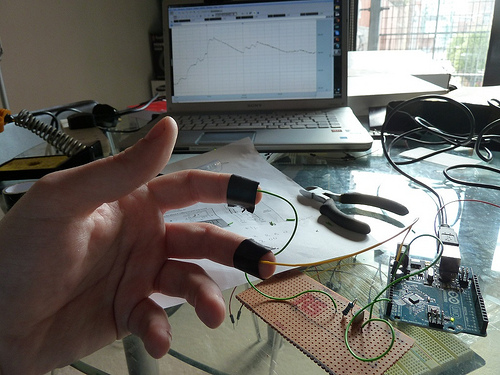Originally posted on PhysiologicalComputing.net.
Following on from my earlier adventure with the stress tester, sat right next door was a love tester, presumably developed by the same company given it was using the same chassis as the stress tester*. The love tester is probably one of the most familiar, and oldest, commercial biofeedback games around. Its function is to assess the sexual magnetism of the player using a comically named rating scale e.g. “Cold and Clammy” for no magnetism, “Out of Control” for lots. A love tester is basically a gag device which uses physiological input to provide some authenticity to the assessment. Their a common prop in media where making fun of the sexual prowess of a character is needed (e.g. The Simpsons); you can often find a love tester in a bar or the funfair if you want to try one out,
Continue reading “"Love is Over" – Gaming a Love Tester”
Tag: physiocomblog
Playing Dark Escape 4D

Originally posted on PhysiologicalComputing.net.
Holidays and arcades are one of my traditions. Come every holiday I hole up in the nearest arcade and play games until my fingers go numb, usually from the re-coil of the light-gun games. Sadly, in my experience, arcade culture in the UK has diminished significantly as the novelty and variety of yesteryear is simply not there any more. Most arcades tend to host a mixture of dated racing and light-gun games (I’m looking at you Time Crisis), which, while were fun at the time have lost their charm. During my recent holiday, much to my surprise, I came across a brand new arcade game which really piqued my interest: Dark Escape 4D by Namco.
And why did this game catch my attention so, well because it was a biofeedback game, a biofeedback game at the ARCADE!
Continue reading “Playing Dark Escape 4D”
Working with Sensors: Transparency versus Quality Assurance

Originally posted on PhysiologicalComputing.net.
Recently I’ve been developing mechanics for a range of biofeedback projects, one of which was featured, over the summer, in an art exhibit at FACT Liverpool. These projects have been developed with the general public in mind, and so I’ve been working with consumer electronics rather than the research grade devices I normally use.
Continue reading “Working with Sensors: Transparency versus Quality Assurance”
Will the Wii Vitality every reach 99% of all customers?
Originally posted on PhysiologicalComputing.net.
At a recent investor conference, Nintendo was rumoured to of stated that the reason the Wii Vitality has not been released was because it only works for 80% of players and before they release it they want it to work for 99%. If this issue concerns the physiological game mechanic (i.e. only 80% of players can control their physiology according to the requirements of the game mechanic), then the product will be on hold for a very long time.
Note: For the purposes of this post I’m going to assume Nintendo are experimenting with a heartbeat (HR) rate based biofeedback relaxation game which they’ve alluded to previously at E3 2009. However what I’m going to say applies equally to all physiological game mechanics I know of and should be borne in mind when developing your own physiological game.
Continue reading “Will the Wii Vitality every reach 99% of all customers?”
Time Keeps on a Slippin
Originally posted on PhysiologicalComputing.net.
Most people I know who work in the field of physiological computing purchase off-the-shelf sensors for their research. There’s nothing specifically wrong with this, most of us are not engineers and nor do we have the time to become one as our interests lie elsewhere. At LJMU all our equipment is off-the-shelf and we have some damn fine devices which we’ve used in our work (e.g. see my review of the BM CS-5 cheststrap). However I’ve noticed we place a lot of faith (and money) in these devices to do what they say on the tin (e.g. see the issue I raised last year about the software bundled with BioHarness). Personally I like to know the limitations of any equipment I’m using, and if I find anything outside the spec I’ll try to figure out why (sometimes to my detriment as you’ll see below). Its not that I’m particularly troubled if a sensor has any defects as I don’t expect them to be perfect, the problem I have is with defects I don’t know about as they can make things, problematic to say the least. For example the first off-the-shelf sensor I ever worked with was the WaveRider Pro a 4 channel biofeedback device which had a slight problem with counting time.
Continue reading “Time Keeps on a Slippin”